A Report on Improving Nursing Practices in Mental Health Care
VerifiedAdded on 2020/10/22
|10
|2456
|276
Report
AI Summary
This report examines the improvement of nursing practices related to mental health, focusing on young adults and children. It identifies areas for enhancement, such as patient safety and risk management, highlighting the need for better communication and understanding of psychological disorders. The report emphasizes evidence-based practice, including the use of multi-disciplinary teams and the PICO framework (Population/Problem, Intervention, Comparison, Outcome) to formulate clinical questions and guide decision-making. It also covers search strategies, systematic literature reviews, and critical appraisal of information to improve clinical judgments and patient outcomes. The conclusion underscores the importance of these practices in enhancing patient safety and psychological well-being. This report is a valuable resource for students seeking to understand and improve mental health nursing care.
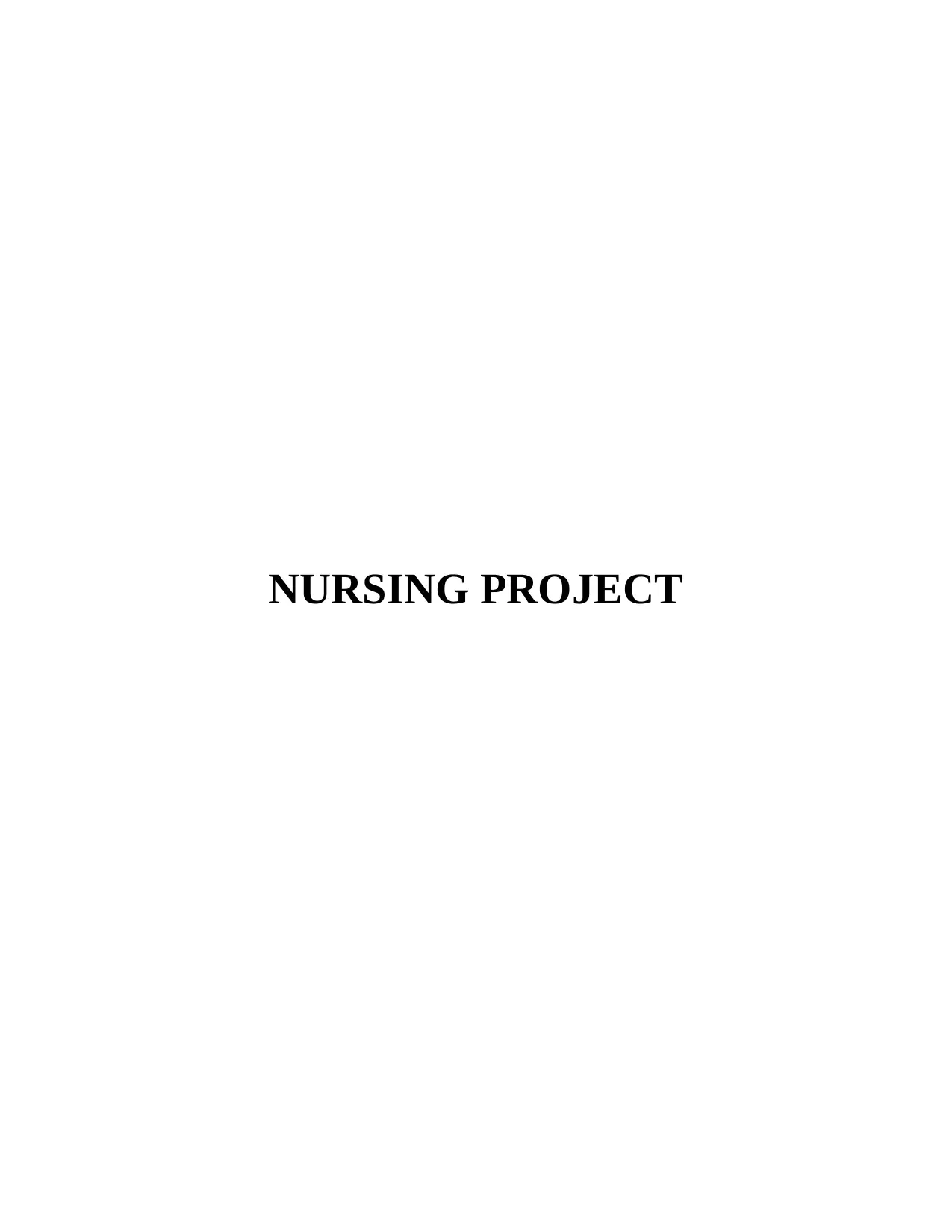
NURSING PROJECT
Paraphrase This Document
Need a fresh take? Get an instant paraphrase of this document with our AI Paraphraser
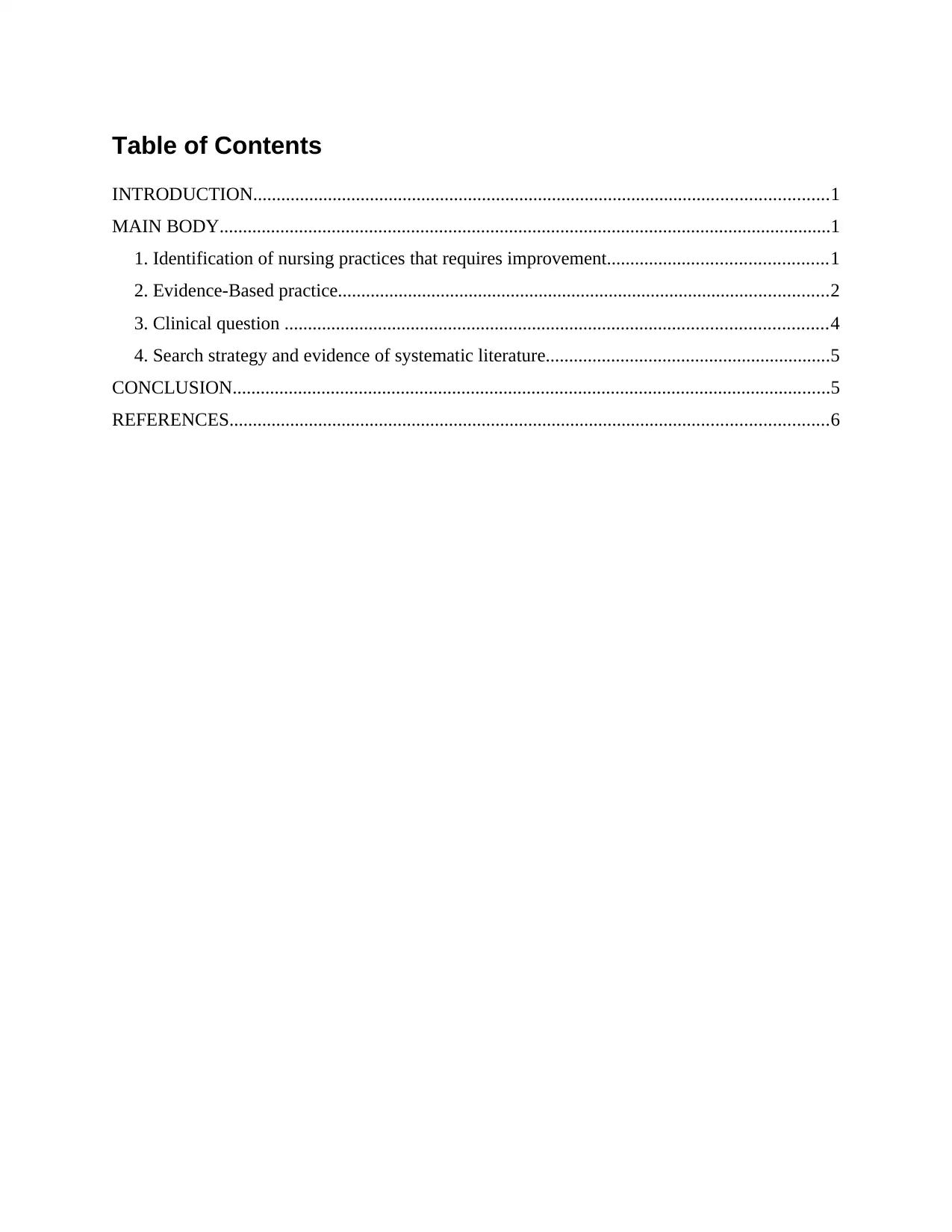
Table of Contents
INTRODUCTION...........................................................................................................................1
MAIN BODY...................................................................................................................................1
1. Identification of nursing practices that requires improvement...............................................1
2. Evidence-Based practice.........................................................................................................2
3. Clinical question ....................................................................................................................4
4. Search strategy and evidence of systematic literature.............................................................5
CONCLUSION................................................................................................................................5
REFERENCES................................................................................................................................6
INTRODUCTION...........................................................................................................................1
MAIN BODY...................................................................................................................................1
1. Identification of nursing practices that requires improvement...............................................1
2. Evidence-Based practice.........................................................................................................2
3. Clinical question ....................................................................................................................4
4. Search strategy and evidence of systematic literature.............................................................5
CONCLUSION................................................................................................................................5
REFERENCES................................................................................................................................6
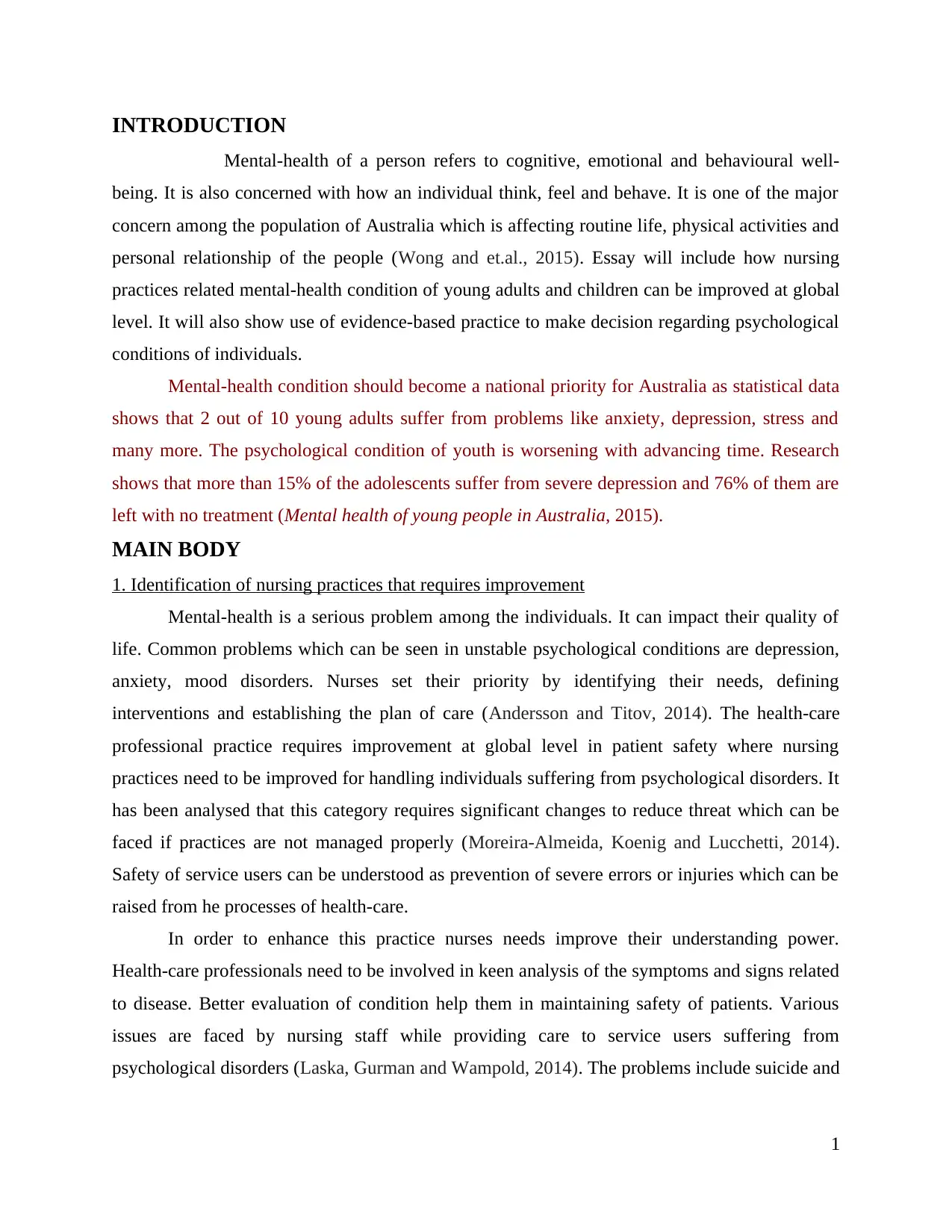
INTRODUCTION
Mental-health of a person refers to cognitive, emotional and behavioural well-
being. It is also concerned with how an individual think, feel and behave. It is one of the major
concern among the population of Australia which is affecting routine life, physical activities and
personal relationship of the people (Wong and et.al., 2015). Essay will include how nursing
practices related mental-health condition of young adults and children can be improved at global
level. It will also show use of evidence-based practice to make decision regarding psychological
conditions of individuals.
Mental-health condition should become a national priority for Australia as statistical data
shows that 2 out of 10 young adults suffer from problems like anxiety, depression, stress and
many more. The psychological condition of youth is worsening with advancing time. Research
shows that more than 15% of the adolescents suffer from severe depression and 76% of them are
left with no treatment (Mental health of young people in Australia, 2015).
MAIN BODY
1. Identification of nursing practices that requires improvement
Mental-health is a serious problem among the individuals. It can impact their quality of
life. Common problems which can be seen in unstable psychological conditions are depression,
anxiety, mood disorders. Nurses set their priority by identifying their needs, defining
interventions and establishing the plan of care (Andersson and Titov, 2014). The health-care
professional practice requires improvement at global level in patient safety where nursing
practices need to be improved for handling individuals suffering from psychological disorders. It
has been analysed that this category requires significant changes to reduce threat which can be
faced if practices are not managed properly (Moreira-Almeida, Koenig and Lucchetti, 2014).
Safety of service users can be understood as prevention of severe errors or injuries which can be
raised from he processes of health-care.
In order to enhance this practice nurses needs improve their understanding power.
Health-care professionals need to be involved in keen analysis of the symptoms and signs related
to disease. Better evaluation of condition help them in maintaining safety of patients. Various
issues are faced by nursing staff while providing care to service users suffering from
psychological disorders (Laska, Gurman and Wampold, 2014). The problems include suicide and
1
Mental-health of a person refers to cognitive, emotional and behavioural well-
being. It is also concerned with how an individual think, feel and behave. It is one of the major
concern among the population of Australia which is affecting routine life, physical activities and
personal relationship of the people (Wong and et.al., 2015). Essay will include how nursing
practices related mental-health condition of young adults and children can be improved at global
level. It will also show use of evidence-based practice to make decision regarding psychological
conditions of individuals.
Mental-health condition should become a national priority for Australia as statistical data
shows that 2 out of 10 young adults suffer from problems like anxiety, depression, stress and
many more. The psychological condition of youth is worsening with advancing time. Research
shows that more than 15% of the adolescents suffer from severe depression and 76% of them are
left with no treatment (Mental health of young people in Australia, 2015).
MAIN BODY
1. Identification of nursing practices that requires improvement
Mental-health is a serious problem among the individuals. It can impact their quality of
life. Common problems which can be seen in unstable psychological conditions are depression,
anxiety, mood disorders. Nurses set their priority by identifying their needs, defining
interventions and establishing the plan of care (Andersson and Titov, 2014). The health-care
professional practice requires improvement at global level in patient safety where nursing
practices need to be improved for handling individuals suffering from psychological disorders. It
has been analysed that this category requires significant changes to reduce threat which can be
faced if practices are not managed properly (Moreira-Almeida, Koenig and Lucchetti, 2014).
Safety of service users can be understood as prevention of severe errors or injuries which can be
raised from he processes of health-care.
In order to enhance this practice nurses needs improve their understanding power.
Health-care professionals need to be involved in keen analysis of the symptoms and signs related
to disease. Better evaluation of condition help them in maintaining safety of patients. Various
issues are faced by nursing staff while providing care to service users suffering from
psychological disorders (Laska, Gurman and Wampold, 2014). The problems include suicide and
1
⊘ This is a preview!⊘
Do you want full access?
Subscribe today to unlock all pages.

Trusted by 1+ million students worldwide
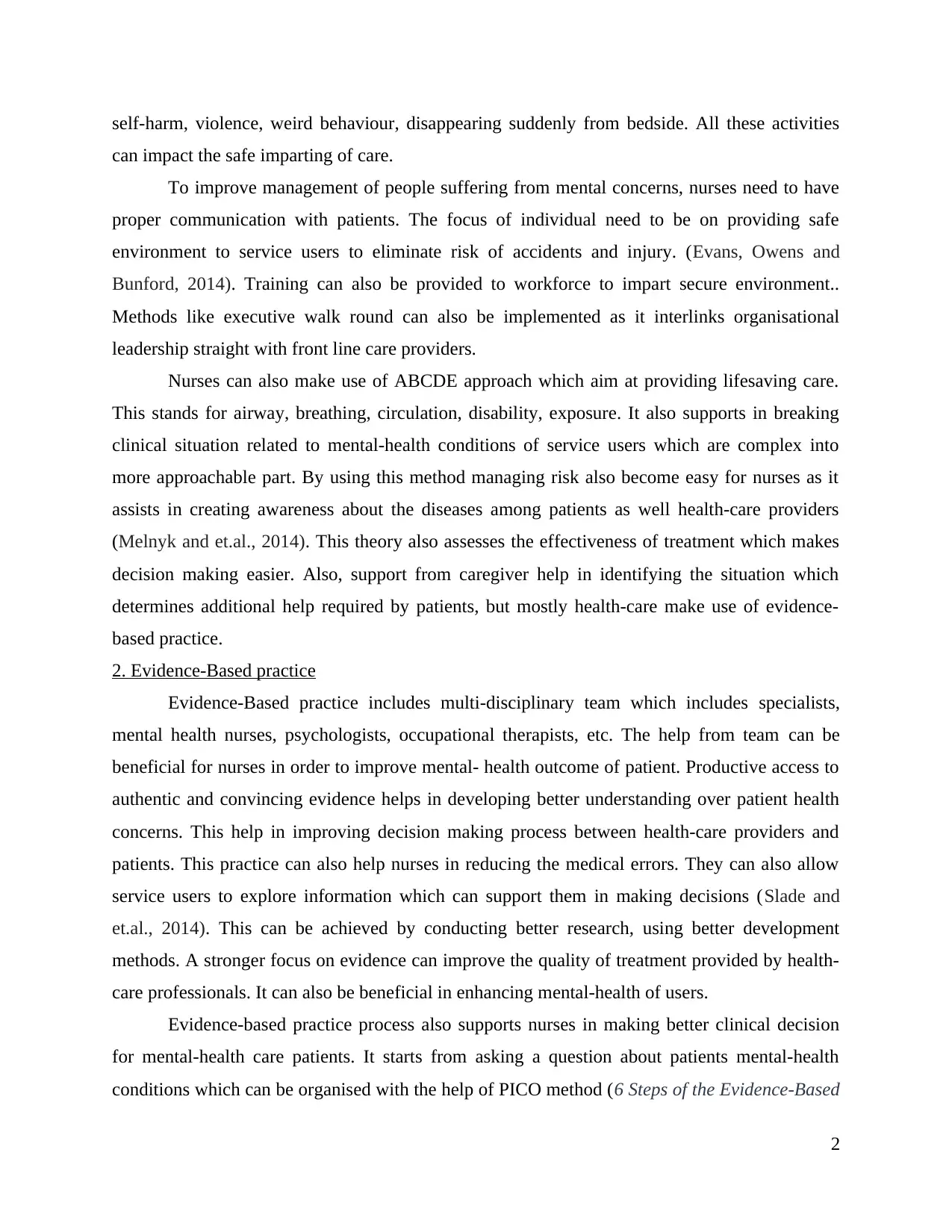
self-harm, violence, weird behaviour, disappearing suddenly from bedside. All these activities
can impact the safe imparting of care.
To improve management of people suffering from mental concerns, nurses need to have
proper communication with patients. The focus of individual need to be on providing safe
environment to service users to eliminate risk of accidents and injury. (Evans, Owens and
Bunford, 2014). Training can also be provided to workforce to impart secure environment..
Methods like executive walk round can also be implemented as it interlinks organisational
leadership straight with front line care providers.
Nurses can also make use of ABCDE approach which aim at providing lifesaving care.
This stands for airway, breathing, circulation, disability, exposure. It also supports in breaking
clinical situation related to mental-health conditions of service users which are complex into
more approachable part. By using this method managing risk also become easy for nurses as it
assists in creating awareness about the diseases among patients as well health-care providers
(Melnyk and et.al., 2014). This theory also assesses the effectiveness of treatment which makes
decision making easier. Also, support from caregiver help in identifying the situation which
determines additional help required by patients, but mostly health-care make use of evidence-
based practice.
2. Evidence-Based practice
Evidence-Based practice includes multi-disciplinary team which includes specialists,
mental health nurses, psychologists, occupational therapists, etc. The help from team can be
beneficial for nurses in order to improve mental- health outcome of patient. Productive access to
authentic and convincing evidence helps in developing better understanding over patient health
concerns. This help in improving decision making process between health-care providers and
patients. This practice can also help nurses in reducing the medical errors. They can also allow
service users to explore information which can support them in making decisions (Slade and
et.al., 2014). This can be achieved by conducting better research, using better development
methods. A stronger focus on evidence can improve the quality of treatment provided by health-
care professionals. It can also be beneficial in enhancing mental-health of users.
Evidence-based practice process also supports nurses in making better clinical decision
for mental-health care patients. It starts from asking a question about patients mental-health
conditions which can be organised with the help of PICO method (6 Steps of the Evidence-Based
2
can impact the safe imparting of care.
To improve management of people suffering from mental concerns, nurses need to have
proper communication with patients. The focus of individual need to be on providing safe
environment to service users to eliminate risk of accidents and injury. (Evans, Owens and
Bunford, 2014). Training can also be provided to workforce to impart secure environment..
Methods like executive walk round can also be implemented as it interlinks organisational
leadership straight with front line care providers.
Nurses can also make use of ABCDE approach which aim at providing lifesaving care.
This stands for airway, breathing, circulation, disability, exposure. It also supports in breaking
clinical situation related to mental-health conditions of service users which are complex into
more approachable part. By using this method managing risk also become easy for nurses as it
assists in creating awareness about the diseases among patients as well health-care providers
(Melnyk and et.al., 2014). This theory also assesses the effectiveness of treatment which makes
decision making easier. Also, support from caregiver help in identifying the situation which
determines additional help required by patients, but mostly health-care make use of evidence-
based practice.
2. Evidence-Based practice
Evidence-Based practice includes multi-disciplinary team which includes specialists,
mental health nurses, psychologists, occupational therapists, etc. The help from team can be
beneficial for nurses in order to improve mental- health outcome of patient. Productive access to
authentic and convincing evidence helps in developing better understanding over patient health
concerns. This help in improving decision making process between health-care providers and
patients. This practice can also help nurses in reducing the medical errors. They can also allow
service users to explore information which can support them in making decisions (Slade and
et.al., 2014). This can be achieved by conducting better research, using better development
methods. A stronger focus on evidence can improve the quality of treatment provided by health-
care professionals. It can also be beneficial in enhancing mental-health of users.
Evidence-based practice process also supports nurses in making better clinical decision
for mental-health care patients. It starts from asking a question about patients mental-health
conditions which can be organised with the help of PICO method (6 Steps of the Evidence-Based
2
Paraphrase This Document
Need a fresh take? Get an instant paraphrase of this document with our AI Paraphraser
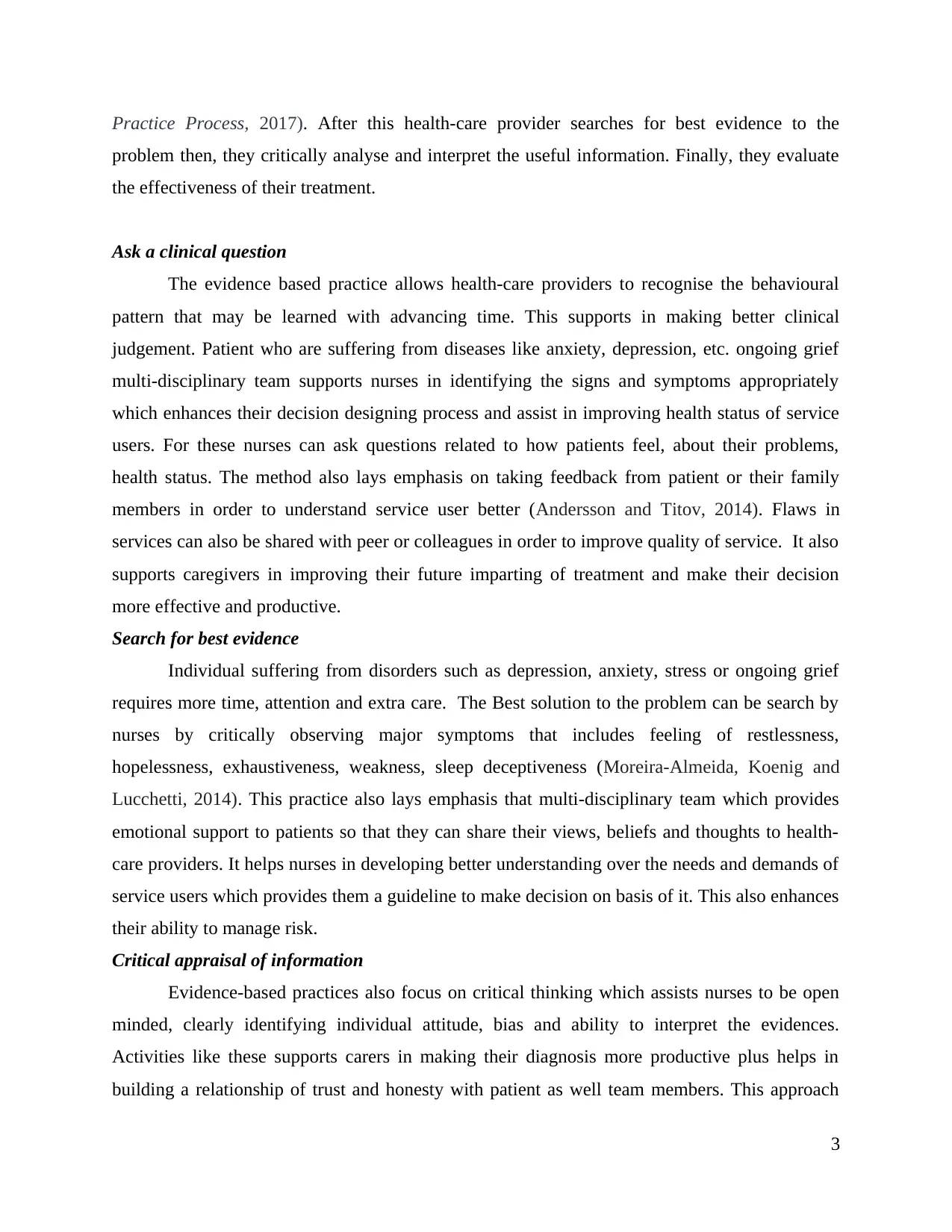
Practice Process, 2017). After this health-care provider searches for best evidence to the
problem then, they critically analyse and interpret the useful information. Finally, they evaluate
the effectiveness of their treatment.
Ask a clinical question
The evidence based practice allows health-care providers to recognise the behavioural
pattern that may be learned with advancing time. This supports in making better clinical
judgement. Patient who are suffering from diseases like anxiety, depression, etc. ongoing grief
multi-disciplinary team supports nurses in identifying the signs and symptoms appropriately
which enhances their decision designing process and assist in improving health status of service
users. For these nurses can ask questions related to how patients feel, about their problems,
health status. The method also lays emphasis on taking feedback from patient or their family
members in order to understand service user better (Andersson and Titov, 2014). Flaws in
services can also be shared with peer or colleagues in order to improve quality of service. It also
supports caregivers in improving their future imparting of treatment and make their decision
more effective and productive.
Search for best evidence
Individual suffering from disorders such as depression, anxiety, stress or ongoing grief
requires more time, attention and extra care. The Best solution to the problem can be search by
nurses by critically observing major symptoms that includes feeling of restlessness,
hopelessness, exhaustiveness, weakness, sleep deceptiveness (Moreira-Almeida, Koenig and
Lucchetti, 2014). This practice also lays emphasis that multi-disciplinary team which provides
emotional support to patients so that they can share their views, beliefs and thoughts to health-
care providers. It helps nurses in developing better understanding over the needs and demands of
service users which provides them a guideline to make decision on basis of it. This also enhances
their ability to manage risk.
Critical appraisal of information
Evidence-based practices also focus on critical thinking which assists nurses to be open
minded, clearly identifying individual attitude, bias and ability to interpret the evidences.
Activities like these supports carers in making their diagnosis more productive plus helps in
building a relationship of trust and honesty with patient as well team members. This approach
3
problem then, they critically analyse and interpret the useful information. Finally, they evaluate
the effectiveness of their treatment.
Ask a clinical question
The evidence based practice allows health-care providers to recognise the behavioural
pattern that may be learned with advancing time. This supports in making better clinical
judgement. Patient who are suffering from diseases like anxiety, depression, etc. ongoing grief
multi-disciplinary team supports nurses in identifying the signs and symptoms appropriately
which enhances their decision designing process and assist in improving health status of service
users. For these nurses can ask questions related to how patients feel, about their problems,
health status. The method also lays emphasis on taking feedback from patient or their family
members in order to understand service user better (Andersson and Titov, 2014). Flaws in
services can also be shared with peer or colleagues in order to improve quality of service. It also
supports caregivers in improving their future imparting of treatment and make their decision
more effective and productive.
Search for best evidence
Individual suffering from disorders such as depression, anxiety, stress or ongoing grief
requires more time, attention and extra care. The Best solution to the problem can be search by
nurses by critically observing major symptoms that includes feeling of restlessness,
hopelessness, exhaustiveness, weakness, sleep deceptiveness (Moreira-Almeida, Koenig and
Lucchetti, 2014). This practice also lays emphasis that multi-disciplinary team which provides
emotional support to patients so that they can share their views, beliefs and thoughts to health-
care providers. It helps nurses in developing better understanding over the needs and demands of
service users which provides them a guideline to make decision on basis of it. This also enhances
their ability to manage risk.
Critical appraisal of information
Evidence-based practices also focus on critical thinking which assists nurses to be open
minded, clearly identifying individual attitude, bias and ability to interpret the evidences.
Activities like these supports carers in making their diagnosis more productive plus helps in
building a relationship of trust and honesty with patient as well team members. This approach
3
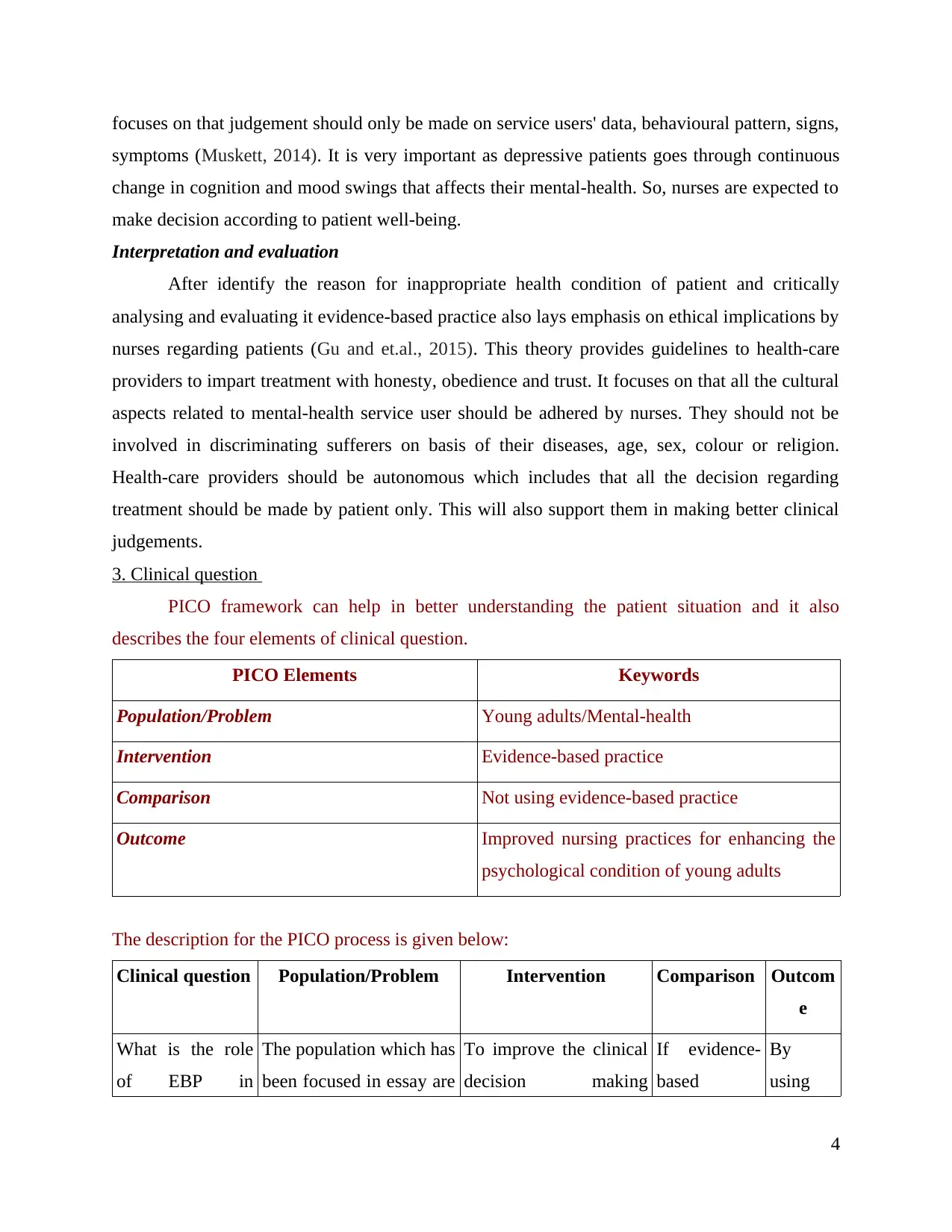
focuses on that judgement should only be made on service users' data, behavioural pattern, signs,
symptoms (Muskett, 2014). It is very important as depressive patients goes through continuous
change in cognition and mood swings that affects their mental-health. So, nurses are expected to
make decision according to patient well-being.
Interpretation and evaluation
After identify the reason for inappropriate health condition of patient and critically
analysing and evaluating it evidence-based practice also lays emphasis on ethical implications by
nurses regarding patients (Gu and et.al., 2015). This theory provides guidelines to health-care
providers to impart treatment with honesty, obedience and trust. It focuses on that all the cultural
aspects related to mental-health service user should be adhered by nurses. They should not be
involved in discriminating sufferers on basis of their diseases, age, sex, colour or religion.
Health-care providers should be autonomous which includes that all the decision regarding
treatment should be made by patient only. This will also support them in making better clinical
judgements.
3. Clinical question
PICO framework can help in better understanding the patient situation and it also
describes the four elements of clinical question.
PICO Elements Keywords
Population/Problem Young adults/Mental-health
Intervention Evidence-based practice
Comparison Not using evidence-based practice
Outcome Improved nursing practices for enhancing the
psychological condition of young adults
The description for the PICO process is given below:
Clinical question Population/Problem Intervention Comparison Outcom
e
What is the role
of EBP in
The population which has
been focused in essay are
To improve the clinical
decision making
If evidence-
based
By
using
4
symptoms (Muskett, 2014). It is very important as depressive patients goes through continuous
change in cognition and mood swings that affects their mental-health. So, nurses are expected to
make decision according to patient well-being.
Interpretation and evaluation
After identify the reason for inappropriate health condition of patient and critically
analysing and evaluating it evidence-based practice also lays emphasis on ethical implications by
nurses regarding patients (Gu and et.al., 2015). This theory provides guidelines to health-care
providers to impart treatment with honesty, obedience and trust. It focuses on that all the cultural
aspects related to mental-health service user should be adhered by nurses. They should not be
involved in discriminating sufferers on basis of their diseases, age, sex, colour or religion.
Health-care providers should be autonomous which includes that all the decision regarding
treatment should be made by patient only. This will also support them in making better clinical
judgements.
3. Clinical question
PICO framework can help in better understanding the patient situation and it also
describes the four elements of clinical question.
PICO Elements Keywords
Population/Problem Young adults/Mental-health
Intervention Evidence-based practice
Comparison Not using evidence-based practice
Outcome Improved nursing practices for enhancing the
psychological condition of young adults
The description for the PICO process is given below:
Clinical question Population/Problem Intervention Comparison Outcom
e
What is the role
of EBP in
The population which has
been focused in essay are
To improve the clinical
decision making
If evidence-
based
By
using
4
⊘ This is a preview!⊘
Do you want full access?
Subscribe today to unlock all pages.

Trusted by 1+ million students worldwide
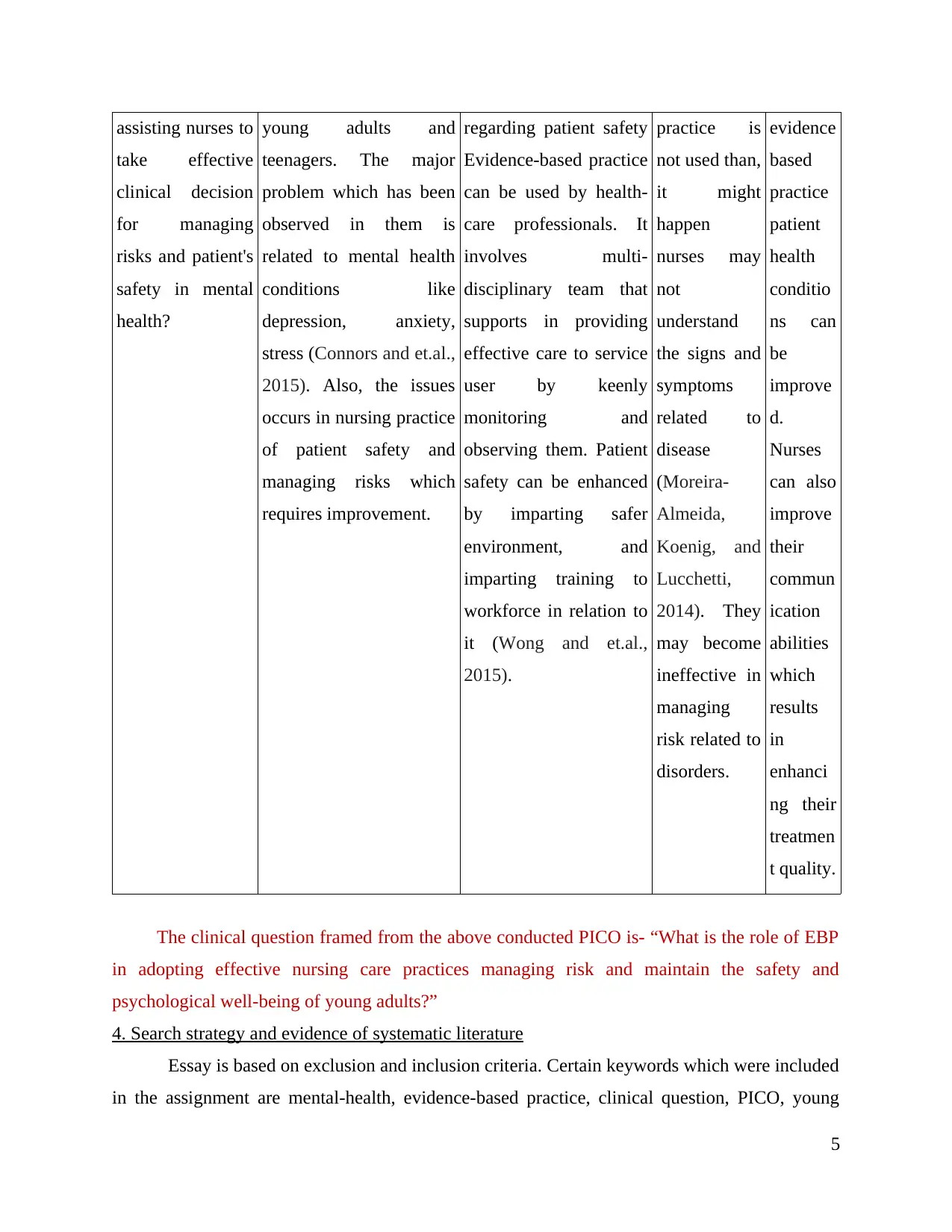
assisting nurses to
take effective
clinical decision
for managing
risks and patient's
safety in mental
health?
young adults and
teenagers. The major
problem which has been
observed in them is
related to mental health
conditions like
depression, anxiety,
stress (Connors and et.al.,
2015). Also, the issues
occurs in nursing practice
of patient safety and
managing risks which
requires improvement.
regarding patient safety
Evidence-based practice
can be used by health-
care professionals. It
involves multi-
disciplinary team that
supports in providing
effective care to service
user by keenly
monitoring and
observing them. Patient
safety can be enhanced
by imparting safer
environment, and
imparting training to
workforce in relation to
it (Wong and et.al.,
2015).
practice is
not used than,
it might
happen
nurses may
not
understand
the signs and
symptoms
related to
disease
(Moreira-
Almeida,
Koenig, and
Lucchetti,
2014). They
may become
ineffective in
managing
risk related to
disorders.
evidence
based
practice
patient
health
conditio
ns can
be
improve
d.
Nurses
can also
improve
their
commun
ication
abilities
which
results
in
enhanci
ng their
treatmen
t quality.
The clinical question framed from the above conducted PICO is- “What is the role of EBP
in adopting effective nursing care practices managing risk and maintain the safety and
psychological well-being of young adults?”
4. Search strategy and evidence of systematic literature
Essay is based on exclusion and inclusion criteria. Certain keywords which were included
in the assignment are mental-health, evidence-based practice, clinical question, PICO, young
5
take effective
clinical decision
for managing
risks and patient's
safety in mental
health?
young adults and
teenagers. The major
problem which has been
observed in them is
related to mental health
conditions like
depression, anxiety,
stress (Connors and et.al.,
2015). Also, the issues
occurs in nursing practice
of patient safety and
managing risks which
requires improvement.
regarding patient safety
Evidence-based practice
can be used by health-
care professionals. It
involves multi-
disciplinary team that
supports in providing
effective care to service
user by keenly
monitoring and
observing them. Patient
safety can be enhanced
by imparting safer
environment, and
imparting training to
workforce in relation to
it (Wong and et.al.,
2015).
practice is
not used than,
it might
happen
nurses may
not
understand
the signs and
symptoms
related to
disease
(Moreira-
Almeida,
Koenig, and
Lucchetti,
2014). They
may become
ineffective in
managing
risk related to
disorders.
evidence
based
practice
patient
health
conditio
ns can
be
improve
d.
Nurses
can also
improve
their
commun
ication
abilities
which
results
in
enhanci
ng their
treatmen
t quality.
The clinical question framed from the above conducted PICO is- “What is the role of EBP
in adopting effective nursing care practices managing risk and maintain the safety and
psychological well-being of young adults?”
4. Search strategy and evidence of systematic literature
Essay is based on exclusion and inclusion criteria. Certain keywords which were included
in the assignment are mental-health, evidence-based practice, clinical question, PICO, young
5
Paraphrase This Document
Need a fresh take? Get an instant paraphrase of this document with our AI Paraphraser
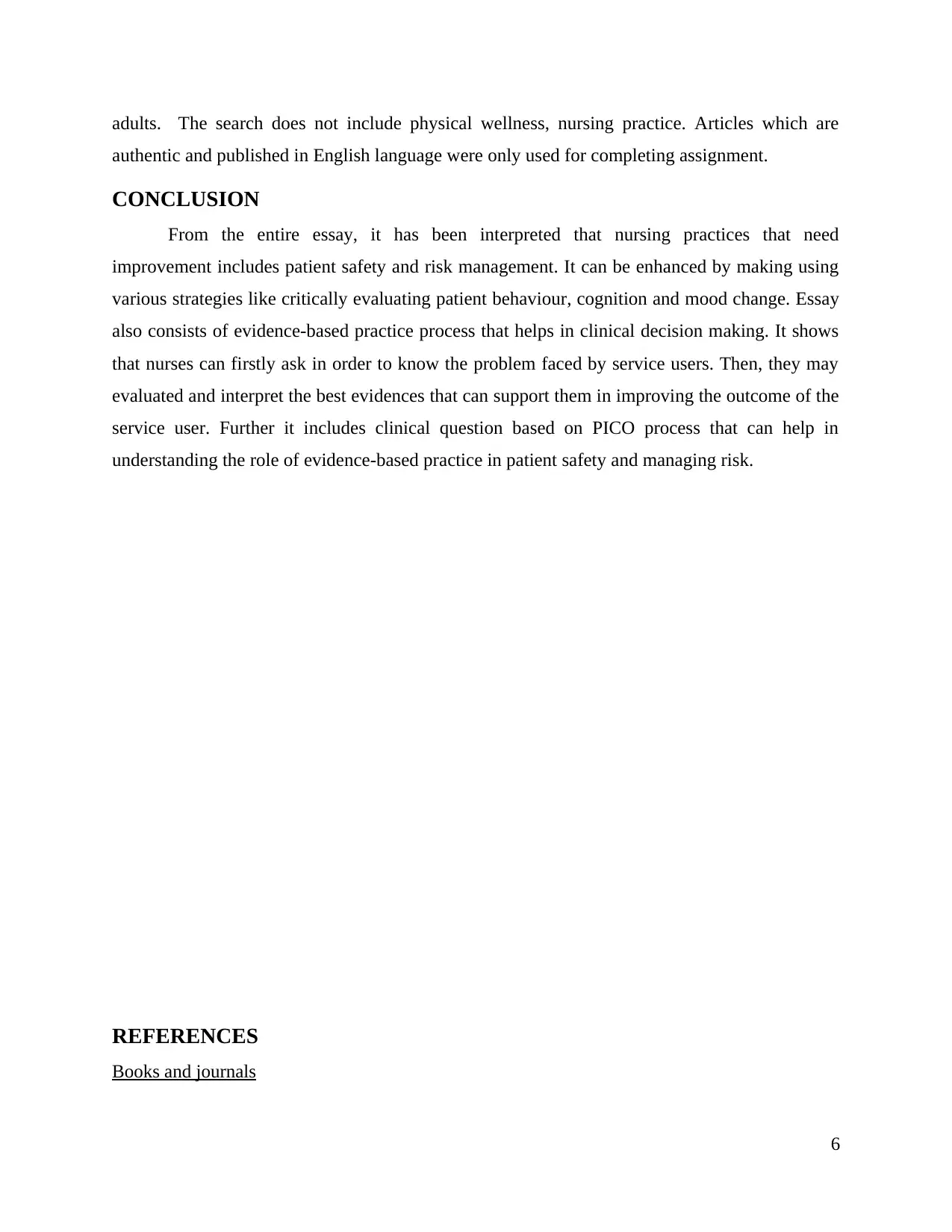
adults. The search does not include physical wellness, nursing practice. Articles which are
authentic and published in English language were only used for completing assignment.
CONCLUSION
From the entire essay, it has been interpreted that nursing practices that need
improvement includes patient safety and risk management. It can be enhanced by making using
various strategies like critically evaluating patient behaviour, cognition and mood change. Essay
also consists of evidence-based practice process that helps in clinical decision making. It shows
that nurses can firstly ask in order to know the problem faced by service users. Then, they may
evaluated and interpret the best evidences that can support them in improving the outcome of the
service user. Further it includes clinical question based on PICO process that can help in
understanding the role of evidence-based practice in patient safety and managing risk.
REFERENCES
Books and journals
6
authentic and published in English language were only used for completing assignment.
CONCLUSION
From the entire essay, it has been interpreted that nursing practices that need
improvement includes patient safety and risk management. It can be enhanced by making using
various strategies like critically evaluating patient behaviour, cognition and mood change. Essay
also consists of evidence-based practice process that helps in clinical decision making. It shows
that nurses can firstly ask in order to know the problem faced by service users. Then, they may
evaluated and interpret the best evidences that can support them in improving the outcome of the
service user. Further it includes clinical question based on PICO process that can help in
understanding the role of evidence-based practice in patient safety and managing risk.
REFERENCES
Books and journals
6
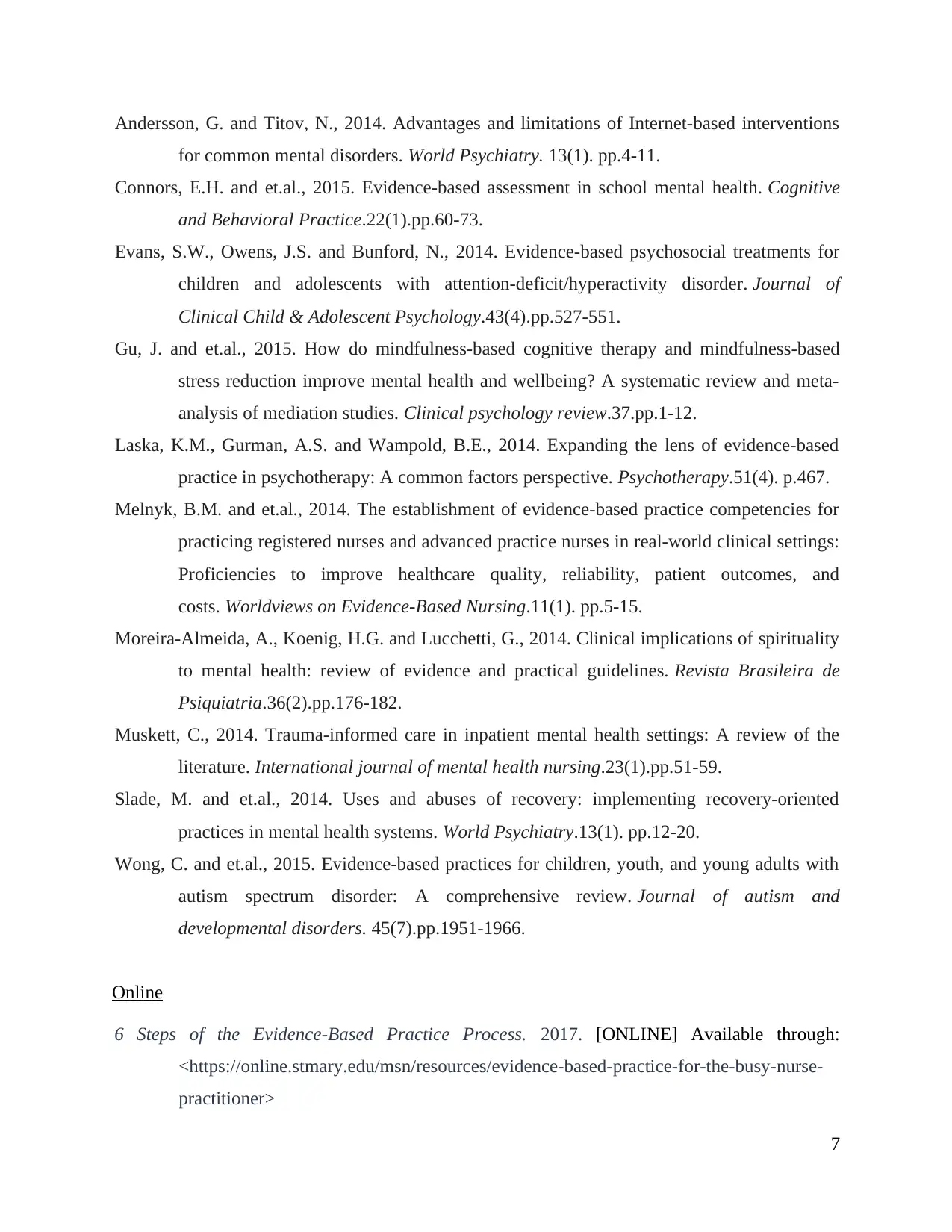
Andersson, G. and Titov, N., 2014. Advantages and limitations of Internet‐based interventions
for common mental disorders. World Psychiatry. 13(1). pp.4-11.
Connors, E.H. and et.al., 2015. Evidence-based assessment in school mental health. Cognitive
and Behavioral Practice.22(1).pp.60-73.
Evans, S.W., Owens, J.S. and Bunford, N., 2014. Evidence-based psychosocial treatments for
children and adolescents with attention-deficit/hyperactivity disorder. Journal of
Clinical Child & Adolescent Psychology.43(4).pp.527-551.
Gu, J. and et.al., 2015. How do mindfulness-based cognitive therapy and mindfulness-based
stress reduction improve mental health and wellbeing? A systematic review and meta-
analysis of mediation studies. Clinical psychology review.37.pp.1-12.
Laska, K.M., Gurman, A.S. and Wampold, B.E., 2014. Expanding the lens of evidence-based
practice in psychotherapy: A common factors perspective. Psychotherapy.51(4). p.467.
Melnyk, B.M. and et.al., 2014. The establishment of evidence‐based practice competencies for
practicing registered nurses and advanced practice nurses in real‐world clinical settings:
Proficiencies to improve healthcare quality, reliability, patient outcomes, and
costs. Worldviews on Evidence‐Based Nursing.11(1). pp.5-15.
Moreira-Almeida, A., Koenig, H.G. and Lucchetti, G., 2014. Clinical implications of spirituality
to mental health: review of evidence and practical guidelines. Revista Brasileira de
Psiquiatria.36(2).pp.176-182.
Muskett, C., 2014. Trauma‐informed care in inpatient mental health settings: A review of the
literature. International journal of mental health nursing.23(1).pp.51-59.
Slade, M. and et.al., 2014. Uses and abuses of recovery: implementing recovery‐oriented
practices in mental health systems. World Psychiatry.13(1). pp.12-20.
Wong, C. and et.al., 2015. Evidence-based practices for children, youth, and young adults with
autism spectrum disorder: A comprehensive review. Journal of autism and
developmental disorders. 45(7).pp.1951-1966.
Online
6 Steps of the Evidence-Based Practice Process. 2017. [ONLINE] Available through:
<https://online.stmary.edu/msn/resources/evidence-based-practice-for-the-busy-nurse-
practitioner>
7
for common mental disorders. World Psychiatry. 13(1). pp.4-11.
Connors, E.H. and et.al., 2015. Evidence-based assessment in school mental health. Cognitive
and Behavioral Practice.22(1).pp.60-73.
Evans, S.W., Owens, J.S. and Bunford, N., 2014. Evidence-based psychosocial treatments for
children and adolescents with attention-deficit/hyperactivity disorder. Journal of
Clinical Child & Adolescent Psychology.43(4).pp.527-551.
Gu, J. and et.al., 2015. How do mindfulness-based cognitive therapy and mindfulness-based
stress reduction improve mental health and wellbeing? A systematic review and meta-
analysis of mediation studies. Clinical psychology review.37.pp.1-12.
Laska, K.M., Gurman, A.S. and Wampold, B.E., 2014. Expanding the lens of evidence-based
practice in psychotherapy: A common factors perspective. Psychotherapy.51(4). p.467.
Melnyk, B.M. and et.al., 2014. The establishment of evidence‐based practice competencies for
practicing registered nurses and advanced practice nurses in real‐world clinical settings:
Proficiencies to improve healthcare quality, reliability, patient outcomes, and
costs. Worldviews on Evidence‐Based Nursing.11(1). pp.5-15.
Moreira-Almeida, A., Koenig, H.G. and Lucchetti, G., 2014. Clinical implications of spirituality
to mental health: review of evidence and practical guidelines. Revista Brasileira de
Psiquiatria.36(2).pp.176-182.
Muskett, C., 2014. Trauma‐informed care in inpatient mental health settings: A review of the
literature. International journal of mental health nursing.23(1).pp.51-59.
Slade, M. and et.al., 2014. Uses and abuses of recovery: implementing recovery‐oriented
practices in mental health systems. World Psychiatry.13(1). pp.12-20.
Wong, C. and et.al., 2015. Evidence-based practices for children, youth, and young adults with
autism spectrum disorder: A comprehensive review. Journal of autism and
developmental disorders. 45(7).pp.1951-1966.
Online
6 Steps of the Evidence-Based Practice Process. 2017. [ONLINE] Available through:
<https://online.stmary.edu/msn/resources/evidence-based-practice-for-the-busy-nurse-
practitioner>
7
⊘ This is a preview!⊘
Do you want full access?
Subscribe today to unlock all pages.

Trusted by 1+ million students worldwide
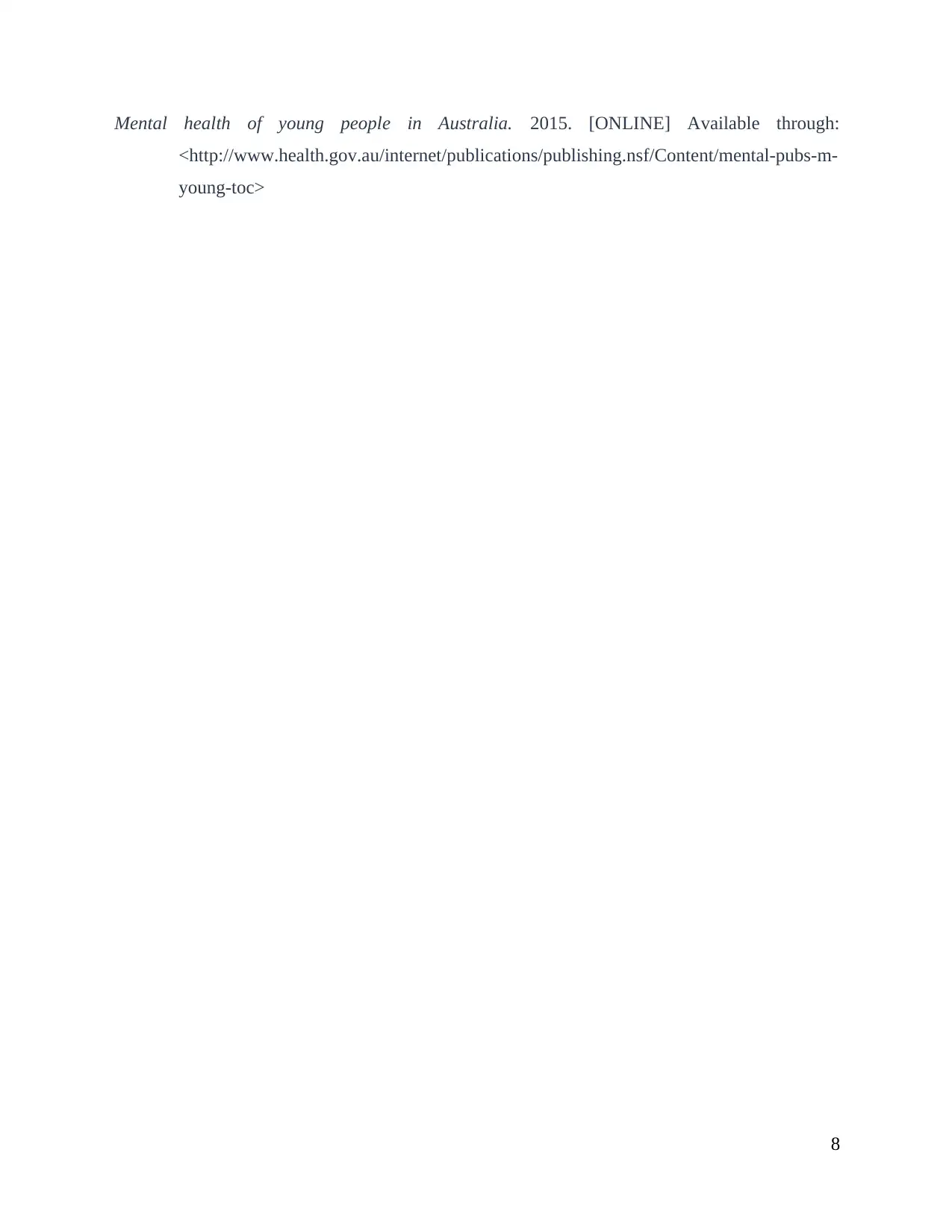
Mental health of young people in Australia. 2015. [ONLINE] Available through:
<http://www.health.gov.au/internet/publications/publishing.nsf/Content/mental-pubs-m-
young-toc>
8
<http://www.health.gov.au/internet/publications/publishing.nsf/Content/mental-pubs-m-
young-toc>
8
1 out of 10
Related Documents
Your All-in-One AI-Powered Toolkit for Academic Success.
+13062052269
info@desklib.com
Available 24*7 on WhatsApp / Email
![[object Object]](/_next/static/media/star-bottom.7253800d.svg)
Unlock your academic potential
Copyright © 2020–2025 A2Z Services. All Rights Reserved. Developed and managed by ZUCOL.





